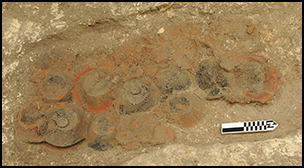Crossref Citations
This article has been cited by the following publications. This list is generated based on data provided by
Crossref.
Sharpe, Ashley E.
Inomata, Takeshi
Triadan, Daniela
Burham, Melissa
MacLellan, Jessica
Munson, Jessica
Pinzón, Flory
and
Zerboni, Andrea
2020.
The Maya Preclassic to Classic transition observed through faunal trends from Ceibal, Guatemala.
PLOS ONE,
Vol. 15,
Issue. 4,
p.
e0230892.
Fladd, Samantha G.
Hedquist, Saul L.
and
Adams, E. Charles
2021.
Trash reconsidered: A relational approach to deposition in the Pueblo Southwest.
Journal of Anthropological Archaeology,
Vol. 61,
Issue. ,
p.
101268.
Juarez, Santiago
2021.
Connecting households: Ceremonial and domestic settlement patterns at the Preclassic site of Noh K’uh in Chiapas, Mexico.
Journal of Anthropological Archaeology,
Vol. 63,
Issue. ,
p.
101331.
MacLellan, Jessica
and
Castillo, Victor
2022.
Between the patio group and the plaza: Round platforms as stages for supra-household rituals in early Maya society.
Journal of Anthropological Archaeology,
Vol. 66,
Issue. ,
p.
101417.
Pugh, Timothy W.
2022.
Social Complexity and the Middle Preclassic Lowland Maya.
Journal of Archaeological Research,
Vol. 30,
Issue. 4,
p.
545.
Sharpe, Ashley E.
and
Aoyama, Kazuo
2023.
LITHIC AND FAUNAL EVIDENCE FOR CRAFT PRODUCTION AMONG THE MIDDLE PRECLASSIC MAYA AT CEIBAL, GUATEMALA.
Ancient Mesoamerica,
Vol. 34,
Issue. 2,
p.
407.
Juarez, Santiago
2023.
The Life and Death of Homes at Noh K'uh: The Cosmological Ceremonies of Late Preclassic Corporate Maya Households.
Ancient Mesoamerica,
Vol. 34,
Issue. 3,
p.
670.
Ahern, Kaitlin R.
2024.
Caches, Memory, and Ritual at the Maya City of Cival.
Latin American Antiquity,
Vol. 35,
Issue. 2,
p.
294.
MacLellan, Jessica
2024.
Settling down at Ceibal and Cuello: variation in the transition to sedentism across the Maya lowlands.
Frontiers in Human Dynamics,
Vol. 6,
Issue. ,
Schroder, Whittaker
Jiménez Álvarez, Socorro del Pilar
Macedo Córdova, Brenda Fernanda
Avilés Arjona, Ariadna Naomi
Lara Bolaños, Guillermo
Ramiro Talavera, Moisés Yerath
and
Godos González, Fernando
2024.
Identification of a Terminal Classic Maya Fine Ware Production Center in the Upper Usumacinta River Drainage, Chiapas, Mexico.
Latin American Antiquity,
Vol. 35,
Issue. 4,
p.
1018.


